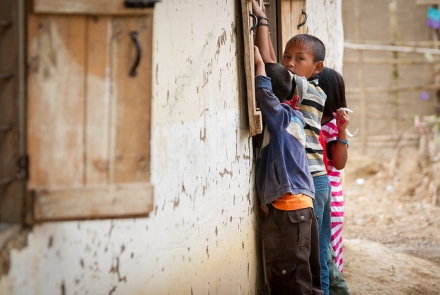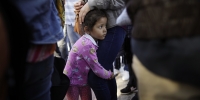
https://www.flickr.com/photos/simpleskye/32768646976/in/photostream/
Using children in political brinkmanship
The juxtaposition of World Refugee Day with heartbreaking scenes of children separated from their parents on the US border couldn’t be starker, and tells us a lot about how public policy can be the cause of societal problems as well as the cure, Sharon Bessell writes.
This week people everywhere marked World Refugee Day – a day intended to commemorate ‘the strength, courage and perseverance of millions of refugees’ and families forced to flee.
In the lead up to World Refugee Day this year, political debate raged in the United States about the Trump administration’s decision to separate families apprehended crossing from Mexico without authorisation. Ultimately, Trump responded – somewhat uncharacteristically – to an outpouring of criticism both within the United States and beyond. But not before many hundreds of children suffered from an appalling game of brinkmanship.
The US Department of Homeland Security reported that 1,995 children were separated from their parents or caregivers between 19 April and 31 May 2018. This reflected a new interpretation of immigration laws, whereby parents are charged with the criminal offence of illegally entering the United States and arrested. Children, who are not charged, are sent to holding centres as their parents are detained and face court.
In Trump’s ‘zero tolerance’ approach to unauthorised border crossings, the separation of children from their parents was both a deterrent and a bargaining chip to force agreement from political opponents.
Across the United States, and across the world, we have been witness to images of terrified toddlers, bewildered teenagers, and very young babies being taken from their desperate parents. The scenes are soul-destroying and heart-breaking. They also highlight the plight of those who are so traumatised in their homelands that they see no future for their children but to flee.
That trauma comes not only from war but also from violence within the home, violence on the streets, deep structural poverty, deep inequality and exclusion, corruption that leads to no hope of justice or protection from crime – the list is long. Not all of these are considered legitimate grounds for seeking refugee status, but all are cause for desperation and hopelessness.
One Brazilian man who crossed the border with his wife, 15-year old daughter and 9-year old son, Goulart do Nascimiento, reportedly told the Court, “I decided to come to the United States with my wife and two children because if I stayed in Brazil they would kill my entire family….Please forgive me. I came with my entire family because I did not want us to be killed.”
Mr Nascimiento’s plea echoes the fear of so many seeking refuge from fear, whether or not they fit the legal definition of ‘refugee’. It also strikes at the heart of parents who have never had to make such a choice but know they would do whatever necessary to protect their children and provide them with some hope for a better future.
World Refugee Day is a moment to reflect on the gap between the vision of protecting children that has shaped much of the international human rights framework over the past century, and the reality faced by many vulnerable children today, not only on the US-Mexico border, but globally.
The UN General Assembly adopted the Convention on the Rights of the Child (UNCRC) in 1989, and it rapidly became the most widely ratified human rights treaty.
The UNCRC defines ‘children’ as those under the age of 18 years and provides a raft of rights, including the right to protection. As a fundamental principle, the Convention requires states parties to act in the best interests of the child. Family reunification is an obligation of states parties under Article 22.
While many countries have ratified the UNCRC only to disregard both the spirit and specific article of the Convention, the United States is the only country not to have ratified it. The United States did become a signatory to the UNCRC in 1995 under the Clinton Administration, but ratification – requiring two-thirds of the Senate to vote in favour – has never proceeded.
The Refugee Convention, a central pillar of the post-World War Two human rights framework, also seeks to protect children, entitling them to the same rights of protection as adults and prioritising family re-unification.
While the international human rights framework has sought to protect children, enormous gaps remain, particularly for children who are forced to flee their country and seek protection across borders.
The principle that governments should support families to protect and care for their children – so often tenuous even when citizenship is assured – breaks down when there is no claim to citizenship, and when claims to asylum are met with open hostility.
In recent years, the dramatic increase in unaccompanied minors (often boys aged 16 or 17 years) seeking asylum in Europe has demonstrated the lack of willingness of many countries to provide support or care.
Of course, most refugees and asylum seekers are not in wealthy countries, but in camps in developing countries, where the provision of protection, care and services is even more elusive.
This gap between the vision of the international human rights framework and the reality facing children and their families in contexts variously characterised by exclusion, suspicion, limited services, and resource scarcity, should be a source of global soul-searching.
More disturbing still are policies adopted, particularly by governments in wealthy countries that consciously violate children’s human rights for base political reasons. The mistreatment of children under Australia’s immigration regime is one such example. In an effort to demonstrate a ‘tough on asylum seekers’ stance for political mileage in some parts of the electorate, successive governments have detained children, including in offshore centres.
A 2014 inquiry by the Australian Human Rights Commission found that Australia then held “around 800 children in mandatory closed immigration detention for indefinite periods, with no pathway to protection or settlement.” In 2016, the United Nations Committee on the Rights of the Child expressed concern that children held in detention on Nauru were suffering serious harm to their mental health and well-being, with children as young as 11 years attempting suicide and engaging in self-harm.
In a particularly disturbing case, a critically ill woman with a diagnosed heart condition was told that she could only leave Nauru for treatment if she left her son behind in detention. Fatemah, originally from Iran, and her 17-year-old son had been in detention on Nauru since 2013. Her son, after spending his adolescence locked up at the pleasure of the Australian Government, suffered from mental illness and was suicidal. Fatemah refused to leave her son and was refused treatment. She was eventually sent to Taiwan for treatment – accompanied by her son – after considerable media coverage of her situation.
As the story unfolded, it appeared that the requirement that Fatemah leave her son in order to receive medical care was a calculated strategy to reinforce the message that those seeking asylum in Australia can expect no compassion for themselves or for their children.
It was also calculated to appeal to a populist sentiment within Australia, and among some members of the government itself, that adopt a hard-line approach to ‘border control’.
But Australia is far from alone. And in the race to the bottom among governments wanting to appear to have full control over their increasingly porous borders, in an increasingly volatile and unequal world, the United States has reached new depths. What is clear is that Trump – a self-described deal-maker – was prepared to use children as a bargaining chip in his own political game as he seeks to make good on election promises.
That Trump eventually took a step back suggests a small glimmer of hope. Despite the deep reluctance of many countries to permit refugees to enter their borders and the embrace of increasingly hard border policies, the violation of children’s human rights to achieve a political outcome is widely rejected. In the United States, both Republicans and Democrats criticised such a strategy.
Public policy has the potential to address deep-seated challenges, including the wicked problems that create flows of people seeking a better life for themselves and their families. It has the potential to protect and support those who flee situations that most of us cannot allow ourselves to even imagine. It has to potential to deliver on the promise made to children through the international human rights framework.
But public policy also has the potential to reinforce inequality, to perpetuate hate, and to foster injustice. It has the potential to be cruel – to deny humanity and dignity to those who are most vulnerable.
What public policy actually achieves is in the hands of those who make decisions and make deals. But it is also in the hands of those who want a world that rejects the use of children as bargaining chips in a perverse game of political brinkmanship. In democracies, as we vote and as we make our voices heard, we may do well to not only consider the future of our own children, but to imagine the futures of children whose lives have been deemed worthless by our governments. The Trump administration’s policy reversal suggests that public pressure can make a difference.
This piece was first published on Policy Forum, Crawford School’s platform for policy analysis and debate.
Updated: 16 August 2024/Responsible Officer: Crawford Engagement/Page Contact: CAP Web Team













